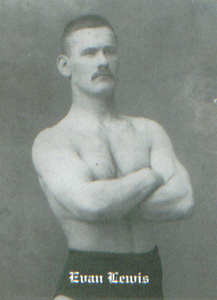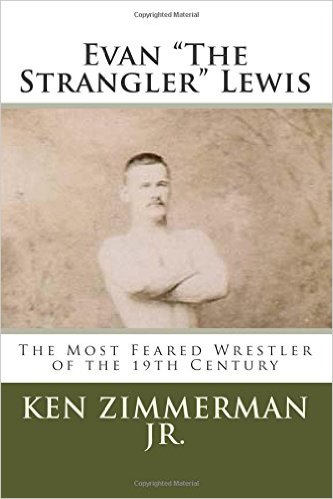Lewis’ thiab lub Acton Hippodrome
Hnub Monday, Lub ob hlis ntuj 7, 1887, Evan “Strangler” Lewis thiab “Me dab” Joe Acton ntsib ntawm Battery D nyob Chicago, Illinois. Nws yuav yog tus thawj ob peb exhibition bouts ntawm cov txiv neej. Lawv tau cov exhibitions loj Midwestern lub zos thaum ntxov 1887. Zoo li cov St. Paul match kuv them rau ib qho ncej ua ntej lawm, Lewis and Acton agreed to the outcome before the match and “ua haujlwm” the match instead of having a legitimate contest.
“Worked” matches were not the rule at this time but they were not uncommon. Wrestlers often cooperated in putting on matches to build excitement for title matches, build bigger houses or avoid too much damage to their bodies in preparation for legitimate matches.

Evan “Strangler” Lewis in his prime from the public domain
Due to their reputations, the wrestling fans were looking forward to an exciting contest. They would get an exciting match but it wasn’t a contest. Some of the wrestling journalist caught on to the “ua haujlwm” nature of the bouts and made side comments. In the case of the St. Paul newspaper, the correspondent flatly stated it was a “hippodrome” or worked exhibition for the purpose of increasing bets on the matches.
They did a great job of convincing the fans that they were in a legitimate contest as 1,000 fans paid the top price of $1.50 for tickets. Another 2,000 fans paid $1.00 for the remaining tickets. Tus $3,500.00 house would be $98,753.00 in today’s money.
The fans thought the winner would get 75 percent of the gate, while the loser would take home 25 feem pua. Txawm li cas los, the wrestlers and promoters were equally splitting the gate and any betting money they could raise.
Due to Lewis’ reputation for trying to cripple other wrestlers, a reputation he richly deserved, a significant number of Chicago Police Command Staff and Officers were present along with several city government officials. Lewis threatened to put Acton in the guillotine choke several times but never applied the controversial hold.
Lewis outweighed the 155-pound Acton by 25 phaus. Lewis was also much more muscular, while Acton appeared “a little fleshy”. Yes Acton won the first fall in ten minutes. After the typical 15 minute break, Lewis even the match up with the second fall in 2 feeb, 30 vib nas this.
The delay between the second and third fall was delayed a little longer than 15 feeb, so that the ringside bookies could encourage more bets. After most of the betting public had made fresh bets, the match restarted.
Ntais ntawv yog 3 tawm ntawm 5 falls, which was fairly standard in the 19th Century. Acton won the next two falls in 7 feeb thiab 6 minutes respectively. Since he scored three falls, the match went to Acton. When they traveled to Saint Paul, it would be Lewis’ turn to win.
While Lewis injured many opponents over the years, he would “ua haujlwm” with wrestlers. The key was not to make him mad. Txwv tsis pub, he would choke you or break bones and snap tendons even if 6 police officers armed with billy clubs invaded the ring. “Working” with Lewis was much healthier.
Koj tuaj tawm tswv yim lossis nug ib lo lus nug hais txog qhov no lossis muaj nqe lus hauv qab no saib hauv qab no lossis rau ntawm kuv Facebook phab.
Qhov chaw: St. Louis Dispatch tom qab, Lub ob hlis ntuj 9, 1887 ib tsab, p. 5 and Inflation Calculator
Pin It

